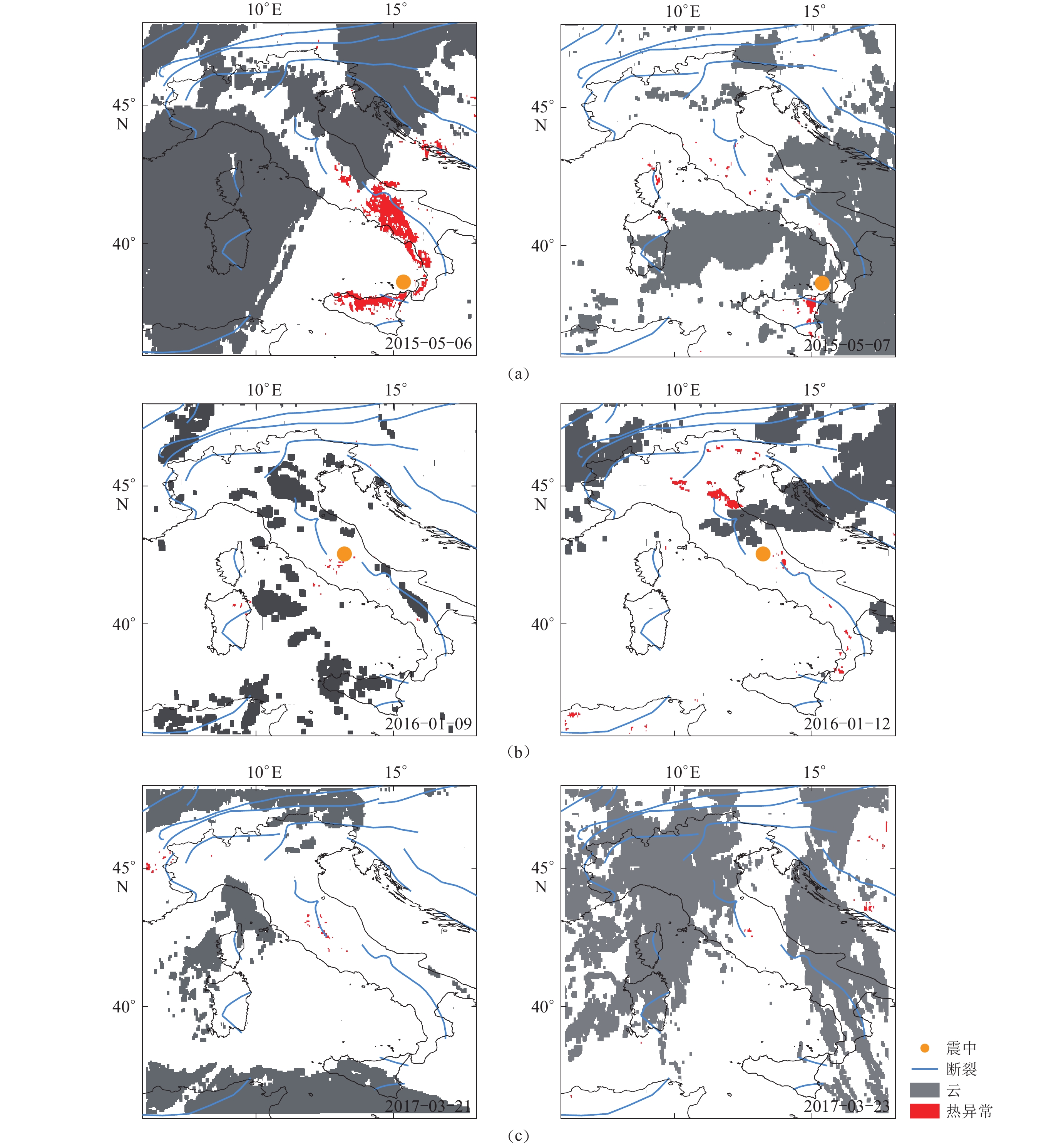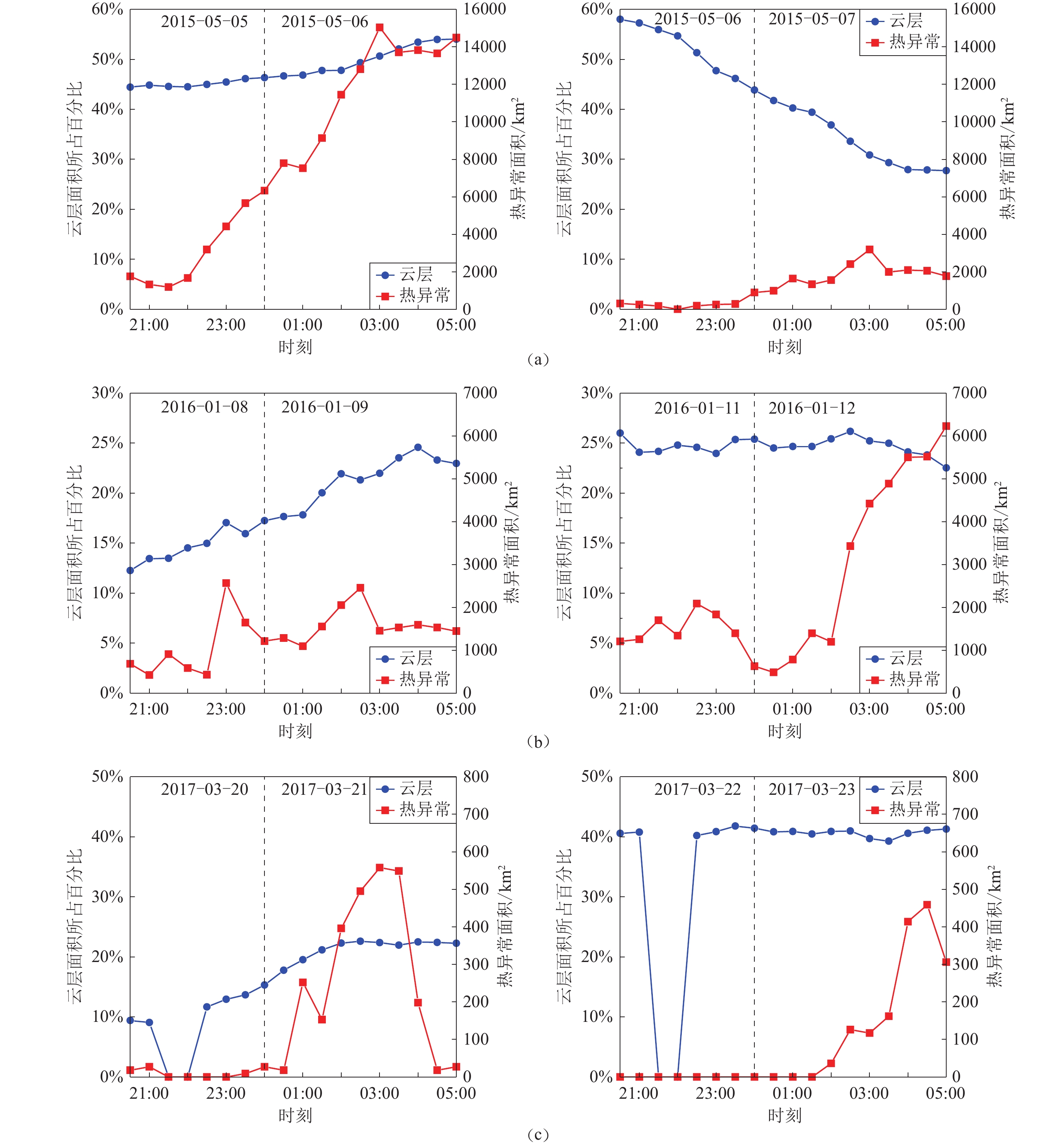Correlation between thermal anomalies and earthquakes based on nighttime multi-temporal remote sensing data
-
摘要: 本文使用第二代欧洲气象卫星MSG搭载的SEVIRI传感器数据,基于卫星数据稳健分析技术提取了意大利地区2015—2017年间的三次热异常,并在此基础上增加热异常的判定条件,利用静止气象卫星的高时间分辨率特性,基于夜间多时相遥感数据探究热异常与地震的相关性。结果显示:通过夜间多时相遥感数据均值可更清晰地展示出研究区热异常的时空变化,基于改进后的判定条件可以有效地判断热异常是否可能与地震有关。此外,夜间多时相热异常的时空分布研究表明,云层的扩散与消失可能对热异常提取结果有重要影响。Abstract: This paper uses the SEVIRI sensor data carried by the second-generation European meteorological satellite MSG to extract the three times thermal anomalies in Italy during the period from 2015 to 2017 based on the robust analysis technology of satellite data, and on this basis, increases a thermal anomaly judgment condition. Taking the high time resolution of the stationary meteorological satellite into consideration, this paper explores the correlation between thermal anomalies and earthquakes based on the characteristics of multi-temporal remote sensing data at night. The results show that the temporal and spatial changes of thermal anomalies in the study area can be displayed more clearly by the multi-temporal mean value of remote sensing data at night, and the improved determination conditions can effectively determine whether the thermal anomalies may be related to earthquakes. In addition, the studies on the temporal and spatial distribution of nighttime multi-temporal thermal anomalies indicate that the spread and disappearance of clouds may have an important impact on the extraction results of thermal anomalies.
-
-
-
陈顺云,刘培洵,刘力强,马瑾,陈国强. 2006. 地表热红外辐射的小波分析及其在现今构造活动研究中的意义[J]. 地球物理学报,49(3):824–830. Chen S Y,Liu P X,Liu L Q,Ma J,Chen G Q. 2006. Wavelet analysis of thermal infrared radiation of land surface and its implication in the study of current tectonic activities[J]. Chinese Journal of Geophysics,49(3):824–830 (in Chinese).
郭晓,张元生,钟美娇,沈文荣,魏从信. 2010. 提取地震热异常信息的功率谱相对变化法及震例分析[J]. 地球物理学报,53(11):2688–2695. Guo X,Zhang Y S,Zhong M J,Shen W R,Wei C X. 2010. Variation characteristics of OLR for the Wenchuan earthquake[J]. Chinese Journal of Geophysics,53(11):2688–2695 (in Chinese).
康春丽,刘德富,荆凤,熊攀,曹忠权. 2011. 大地震红外辐射异常信息时空特征分析[J]. 地球物理学进展,26(6):1897–1905. Kang C L,Liu D F,Jing F,Xiong P,Cao Z Q. 2011. Study on the indication of infrared radiation prior to impending strong earthquakes[J]. Progress in Geophysics,26(6):1897–1905 (in Chinese).
李继业,任建辉,高峰,胡滨生,孟令蕾. 2011. 地震红外长波辐射短期异常特征分析[J]. 中国地震,27(4):410–418. Li J Y,Ren J H,Gao F,Hu B S,Meng L L. 2011. Analysis of short-term earthquake anomaly for outgoing longwave radiation information[J]. Earthquake Research in China,27(4):410–418 (in Chinese).
刘军,刘小阳,薄海光,宗超,马未宇. 2014. 基于引潮力附加构造应力调制的九江地震热异常时空动态过程研究[J]. 地震学报,36(3):514–521. Liu J,Liu X Y,Bo H G,Zong C,Ma W Y. 2014. Spatio-temporal dynamic variation of thermal anomalies before and after the 2005 Jiujiang MS5.7 earthquake based on the modulation of additive tectonics stress induced by tide-generating force[J]. Acta Seismologica Sinica,36(3):514–521 (in Chinese).
吕月琳,毛玉平,史正涛. 2009. 热红外遥感在地震监测预测中的应用[J]. 科技导报,27(6):91–96. Lü Y L,Mao Y P,Shi Z T. 2009. Thermal infrared remote sensing applied to earthquake monitoring and prediction[J]. Science &Technology Review,27(6):91–96 (in Chinese).
马未宇,徐秀登,张行才,吴华锋,徐保华. 2006. NCEP温度图像与天体引潮力附加构造应力结合作地震短临预测初探:以2003年7—8月3次西藏地震为例[J]. 地震地质,28(3):447–455. Ma W Y,Xu X D,Zhang X C,Wu H F,Xu B H. 2006. A preliminary study on the use of NCEP temperature images and astro-tidal-triggering to forecast short-impending earthquake[J]. Seismology and Geology,28(3):447–455 (in Chinese).
强祖基,徐秀登,赁常恭. 1990. 卫星热红外异常:临震前兆[J]. 科学通报,35(17):1324–1327. Qiang Z J,Xu X D,Dian C G. 1990. Satellite thermal infrared anomalies:Precursor for impending earthquake[J]. Chinese Science Bulletin,35(17):1324–1327 (in Chinese). doi: 10.1360/csb1990-35-17-1324
宋冬梅,臧琳,单新建,袁媛,崔建勇,邵红梅,沈晨,时洪涛. 2016. 基于LST年趋势背景场的地震热异常提取算法[J]. 地震地质,38(3):680–695. Song D M,Zhang L,Shan X J,Yuan Y,Cui J Y,Shao H M,Shen C,Shi H T. 2016. A study on the algorithm for extracting earthquake thermal infrared anomalies based on the yearly trend of LST[J]. Seismology and Geology,38(3):680–695 (in Chinese).
孙珂. 2017. 基于卫星遥感反演的地震热红外算法及特征研究[D]. 北京: 中国地震局地质研究所: 49−50. Sun K. 2007. Study on Seismic Thermal Infrared Algorithm and Characteristics Based on Satellite Remote Sensing Retrieval[D]. Beijing: Institute of Geology, China Earthquake Administrator: 49−50 (in Chinese).
魏从信,张元生,王莹. 2018. 日本MW9.1地震对区域热辐射背景场影响的时频分析[J]. 地震学报,40(2):205–214. Wei C X,Zhang Y S,Wang Y. 2018. Time-frequency analysis of the influence of Japan MW9.1 earthquake on regional thermal radiation background field[J]. Acta Seismologica Sinica,40(2):205–214 (in Chinese).
吴立新,刘善军,吴育华,李永强. 2004. 遥感-岩石力学(Ⅳ):岩石压剪破裂的热红外辐射规律及其地震前兆意义[J]. 岩石力学与工程学报,23(4):539–544. Wu L X,Liu S J,Wu Y H,Li Y Q. 2004. Remote-sensing-rock mechanics (Ⅳ):Laws of thermal infrared radiation from compressively-sheared fracturing of rock and its meanings for earthquake omens[J]. Chinese Journal of Rock Mechanics and Engineering,23(4):539–544 (in Chinese).
吴立新,秦凯,刘善军. 2017. 断裂活动及孕震过程遥感热异常分析的研究进展[J]. 测绘学报,46(10):1470–1481. Wu L X,Qin K,Liu S J. 2017. Progress in analysis to remote sensed thermal abnormity with fault activity and seismogenic process[J]. Acta Geodaetica et Cartographica Sinica,46(10):1470–1481 (in Chinese).
徐清. 2013. 欧洲静止气象卫星一瞥[J]. 国际太空,(9):29–32. Xu Q. 2013. Eurostat at a glance[J]. International Space,(9):29–32 (in Chinese).
张元生,郭晓,钟美娇,沈文荣,李稳,何斌. 2010. 汶川地震卫星热红外亮温变化[J]. 科学通报,55(10):904–910. Zhang Y S,Guo X,Zhong M J,Shen W R,Li W,He B. 2010. Wenchuan earthquake:Brightness temperature changes from satellite infrared information[J]. Chin Science Bulletin,55(18):1917–1924.
Choudhury S,Dasgupta S,Saraf A K,Panda S. 2006. Remote sensing observations of pre-earthquake thermal anomalies in Iran[J]. Int J Remote Sens,27(20):4381–4396. doi: 10.1080/01431160600851827
Cuomo V,Filizzola C,Pergola N,Pietrapertosa C,Tramutoli V. 2004. A self-sufficient approach for GERB cloudy radiance detection[J]. Atmos Res,72(1/2/3/4):39–56.
Eleftheriou A,Filizzola C,Genzano N,Lacava T,Lisi M,Paciello R,Pergola N,Vallianatos F,Tramutoli V. 2015. Long-term RST analysis of anomalous TIR sequences in relation with earthquakes occurred in Greece in the period 2004−2013[J]. Pure Appl Geophys,173(1):285–303.
Filizzola C,Pergola N,Pietrapertosa C,Tramutoli V. 2004. Robust satellite techniques for seismically active areas monitoring:A sensitivity analysis on September 7,1999 Athens’s earthquake[J]. Phys Chem Earth,29(4/5/6/7/8/9):517–527.
Genzano N,Aliano C,Corrado R,Filizzola C,Lisi M,Mazzeo G,Paciello R,Pergola N,Tramutoli V. 2009. RST analysis of MSG-SEVIRI TIR radiances at the time of the Abruzzo 6 April 2009 earthquake[J]. Nat Hazards Earth Syst Sci,9(6):2073–2084. doi: 10.5194/nhess-9-2073-2009
Genzano N,Filizzola C,Paciello R,Pergola N,Tramutoli V. 2015. Robust Satellite Techniques (RST) for monitoring earthquake prone areas by satellite TIR observations:The case of 1999 Chi-Chi earthquake (Taiwan)[J]. J Asian Earth Sci,114:289–298. doi: 10.1016/j.jseaes.2015.02.010
Ma W Y,Wang H,Li F S,Ma W M. 2012. Relation between the celestial tide-generating stress and the temperature variations of the Abruzzo M=6.3 earthquake in April 2009[J]. Nat Hazards Earth Syst Sci,12(3):819–827.
Tramutoli V. 1998. Robust AVHRR techniques (RAT) for environmental monitoring: Theory and applications[C]//Proceedings of SPIE 3496, Earth Surface Remote Sensing Ⅱ . Barcelona, Spain: SPIE: 101–113.
Tramutoli V,Di Bello G,Pergola N,Piscitelli S. 2001. Robust satellite techniques for remote sensing of seismically active areas[J]. Ann Geophys,44(2):295–312.
Tramutoli V,Aliano C,Corrado R,Filizzola R,Genzano N,Lisi M,Martinelli G,Pergola N. 2013. On the possible origin of thermal infrared radiation (TIR) anomalies in earthquake-prone areas observed using robust satellite techniques (RST)[J]. Chem Geol,339:157–168. doi: 10.1016/j.chemgeo.2012.10.042
Yao Q L,Qiang Z J. 2012. Thermal infrared anomalies as a precursor of strong earthquakes in the distant future[J]. Nat Hazards,62(3):991–1003. doi: 10.1007/s11069-012-0130-8
Zhang Y,Meng Q Y. 2019. A statistical analysis of TIR anomalies extracted by RSTs in relation to an earthquake in the Sichuan area using MODIS LST data[J]. Nat Hazards Earth Syst Sci,19(3):535–549. doi: 10.5194/nhess-19-535-2019
-
期刊类型引用(1)
1. 郭明瑞,张宇,张兴国,王锡娇,张慧,曾涛,杨世杰,卢启明,庞雪华. 琼中地电场观测干扰排查实验分析. 地震地磁观测与研究. 2024(05): 98-106 .  百度学术
百度学术
其他类型引用(0)





 下载:
下载:




